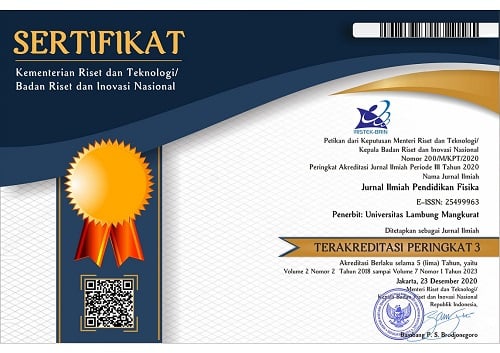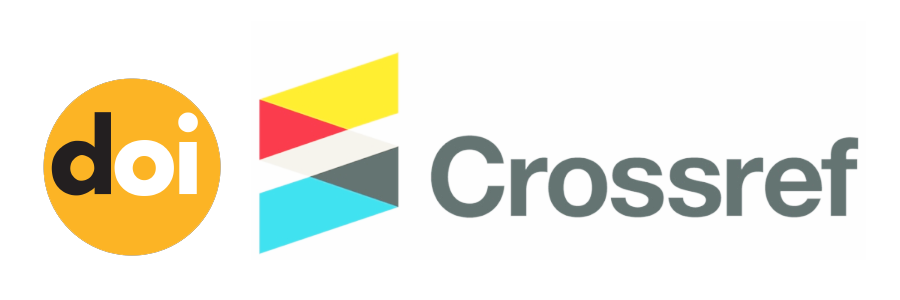Development of an Integrated Physics Learning Module Using Augmented Reality (AR) with Al-Qur'an on Fluid Material for Senior High School
Abstract
Keywords
Full Text:
PDFReferences
Afifah, B., Widiyaningtyas, T., & Pujianto, U. (2019). Pengembangan bahan ajar perakitan komputer bermuatan augmented reality untuk menumbuhkan keaktifan belajar siswa. Tekno, 29(2), 97. https://doi.org/10.17977/um034v29i2p97-115
Arth, C., Grasset, R., Gruber, L., Langlotz, T., Mulloni, A., & Wagner, D. (2015). The History of Mobile Augmented Reality. arXiv preprint arXiv:1505.01319.
Chandra, A. N., Haryati, S., & Haris, V. (2020). Desain lkpd fisika berorientasi al-qur’an dengan strategi inkuiri terbimbing terhadap pencapaian kompetensi peserta didik sma/ma. Sainstek : Jurnal Sains Dan Teknologi, 12(1), 5. https://doi.org/10.31958/js.v12i1.2198
Darma, R. S., Setyadi, A., Wilujeng, I., Jumadi, & Kuswanto, H. (2019). Multimedia learning module development based on sigil software in physics learning. Journal of Physics: Conference Series, 1233(1). https://doi.org/10.1088/1742-6596/1233/1/012042
Eh Phon, D. N., Ali, M. B., & Halim, N. D. A. (2014). Collaborative augmented reality in education: A review. Proceedings-2014 International Conference on Teaching and Learning in Computing and Engineering, LATICE 2014, 78–83.
https://doi.org/10.1109/LaTiCE.2014.23
Elmqaddem, N. (2019). Augmented reality and virtual reality in education. Myth or reality? International Journal of Emerging Technologies in Learning, 14(3), 234–242. https://doi.org/10.3991/ijet.v14i03.9289
Firmansyah, J., Suhandi, A., Setiawan, A., & Permanasari, A. (2020). Development of augmented reality in the basic physics practicum module. Journal of Physics: Conference Series, 1521(2). https://doi.org/10.1088/1742-6596/1521/2/022003
Jamali, S. S., Shiratuddin, M. F., Wong, K. W., & Oskam, C. L. (2015). Utilising mobile-augmented reality for learning human anatomy. Procedia-Social and Behavioral Sciences, 197(February), 659–668. https://doi.org/10.1016/j.sbspro.2015.07.054
Jeřábek, T., Rambousek, V., & Wildová, R. (2014). Specifics of visual perception of the augmented reality in the context of education. Procedia - Social and Behavioral Sciences, 159, 598–604. https://doi.org/10.1016/j.sbspro.2014.12.432
Kesim, M., & Ozarslan, Y. (2012). Augmented reality in education: current technologies and the potential for education. Procedia - Social and Behavioral Sciences, 47(222), 297–302.
https://doi.org/10.1016/j.sbspro.2012.06.654
Khunaeni, L. N., Yuniarti, W. D., & Khalif, M. A. (2020). Pengembangan modul fisika berbantuan teknologi augmented reality pada materi gelombang bunyi untuk sma/ma kelas xi. Physics Education Research Journal, 2(2), 83. https://doi.org/10.21580/perj.2020.2.2.6144
Kurniawan, A., & Badiah, L. I. (2022). Pengembangan media modul digital interaktif pembelajaran braille berbasis inklusi untuk meningkatkan hasil belajar mahasiswa. JPI (Jurnal Pendidikan Inklusi), 5(1), 006–012. https://doi.org/10.26740/inklusi.v5n1.p006-012
Lee, K. (2012). Augmented reality in education and training. TechTrends, 56(2), 13–21. https://doi.org/10.1007/s11528-012-0559-3
Mardayani, S., Hamdi, & Murtiani; (2013). Pengembangan bahan ajar fisika yang terintegrasi nilai-nilai ayat al-quran pada materi gerak. Pillar Of Physics Education, 1(0), 39–47.
Mustaqim, I., & Kurniawan, N. (2017). Pengembangan Media Pembelajaran Berbasis Augmented Reality. Jurnal Edukasi Elektro, 1(1).
Nurhasana, P. D., Aryaningrum, K., Kuswidyanarko, A., Fakhurdin, A., Pratama, A., Riyanti, H., Selegi, S. F., Anggraini, D., & Kalsum, U. (2022). Pelatihan inovasi media pembelajaran berbasis augmented reality (ar) melalui aplikasi assemblr program studi pendidikan guru sekolah dasar Jurnal Sinergitas PKM & CSR, 6(1), 1.
https://doi.org/10.19166/jspc.v6i1.4957
O’Shea, P. M. (2011). Augmented reality in education. International Journal of Gaming and Computer-Mediated Simulations, 3(1), 91–93. https://doi.org/10.4018/jgcms.2011010108
Prastowo, A. (2014). Pengembangan bahan ajar tematik : tinjauan teoritis dan praktik / Andi Prastowo | OPAC Perpustakaan Nasional RI.
Prastowo, A. (2015). Panduan kreatif membuat bahan ajar inovatif. DIVA Press.
Purwandari, P., Yusro, A. C., & Purwito, A. (2021). Modul fisika berbasis augmented reality sebagai alternatif sumber belajar siswa. Jurnal Ilmiah Pendidikan Fisika, 5(1), 38-46.
Puspitasari, A. D. (2019). Penerapan media pembelajaran fisika menggunakan modul cetak dan modul elektronik pada siswa sma. Jurnal Pendidikan Fisika, 7(1), 17–25.
Rahdiyanta, D. (2016). Teknik penyusunan modul pembelajaran. Academia, 1–14.
Riduan. (2007). Belajar mudah penelitian : untuk guru, karyawan dan peneliti pemula | perpustakaan Universitas Negeri Makassar. Alfabeta.
Rissa Putri Intari Dewi, P., Made Winda Wijayanti, N., & Dewa Putu Juwana, I. (2022). Efektivitas penerapan media pembelajaran digital assemblr edu pada mata pelajaran matematika di smk negeri 4 denpasar. Jurnal PKM, Widya Mahadi, 2(2), 98–109.
https://doi.org/10.5281/zenodo.6606066
Saidin, N. F., Halim, N. D. A., & Yahaya, N. (2015). A review of research on augmented reality in education: Advantages and applications. International Education Studies, 13, 1–8.
https://doi.org/10.5539/ies.v8n13p1
Saidin, N. F., Halim, N. D. A., & Yahaya, N. (2019). Framework for developing a Mobile Augmented Reality for learning chemical bonds. International Journal of Interactive Mobile Technologies, 13(7), 54–68. https://doi.org/10.3991/ijim.v13i07.10750
Selisne, M., Sari, Y. S., & Ramli, R. (2019). Role of learning module in STEM approach to achieve competence of physics learning. Journal of Physics: Conference Series, 1185(1). https://doi.org/10.1088/1742-6596/1185/1/012100
Serevina, V., Astra, I., & Sari, I. J. (2018). Development of e-module based on problem based learning (pbl) on heat and temperature to improve student's science process skill. Turkish Online Journal of Educational Technology-TOJET, 17(3), 26-36.
Sharma, S., Stigal, J., & Bodempudi, S. T. (2020). Situational awareness-based augmented reality instructional (ari) module for building evacuation. Proceedings - 2020 IEEE Conference on Virtual Reality and 3D User Interfaces, VRW 2020, 70–78.
https://doi.org/10.1109/VRW50115.2020.00020
Sugiyono. (2014). Metode Penelitian kuantitatif, kualitatif dan R & D / Sugiyono | OPAC Perpustakaan Nasional RI. Alfabeta.
Sukardiyono, & Wardani, Y. R. (2013). Pengembangan modul fisika berbasis kerja laboratorium dengan pendekatan science process skills untuk meningkatkan hasil belajar fisika development of physics module laboratory work based by science. Jurnal Pendidikan Matematika Dan Sains Tahun I, 2, 185–195.
Suprapto, N., Ibisono, H. S., & Mubarok, H. (2021). The use of physics pocketbook based on augmented reality on planetary motion to improve students’ learning achievement. Journal of Technology and Science Education, 11(2), 526–540. https://doi.org/10.3926/jotse.1167
Yovan, R. A. R., & Kholiq, A. (2022). Pengembangan media augmented reality untuk melatih keterampilan berpikir abstrak siswa SMA pada materi medan magnet. PENDIPA Journal of Science Education, 6(1), 80-87.
https://doi.org/10.33369/pendipa.6.1.80-87
DOI: https://doi.org/10.20527/jipf.v7i2.8720
Refbacks
- There are currently no refbacks.
Indexed by: Jurnal Ilmiah Pendidikan Fisika is licensed under a creative commons attribution-share alike 4.0 international license
Statistics Counter |
















